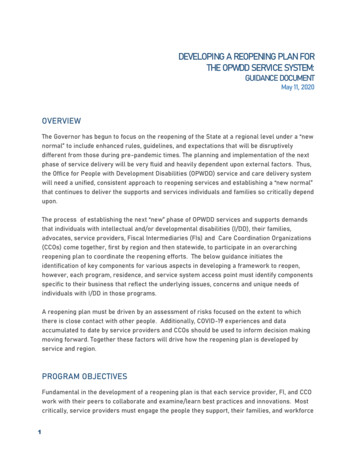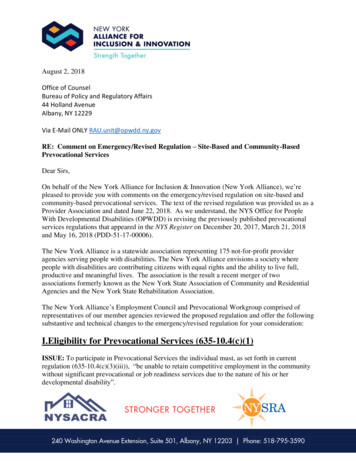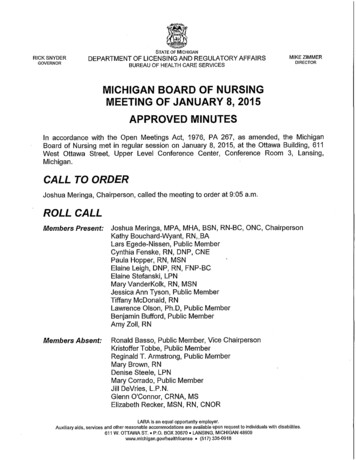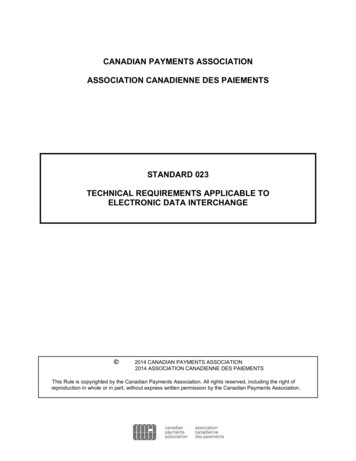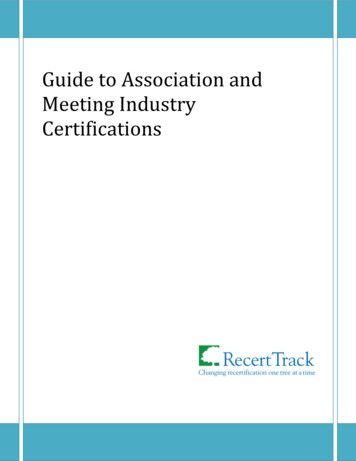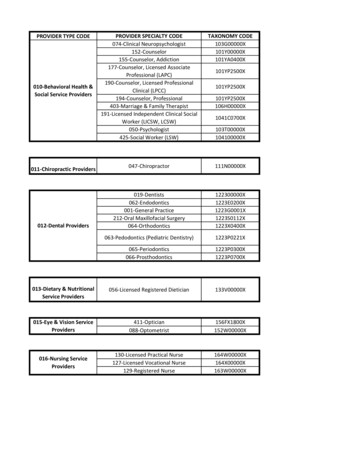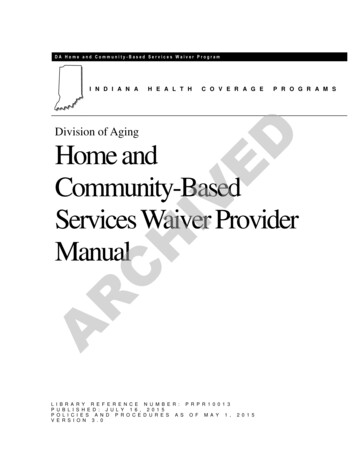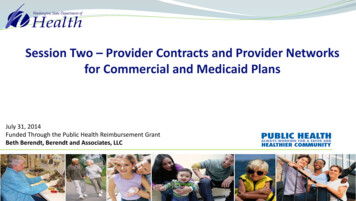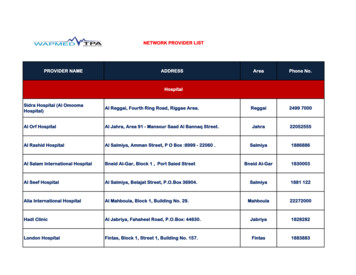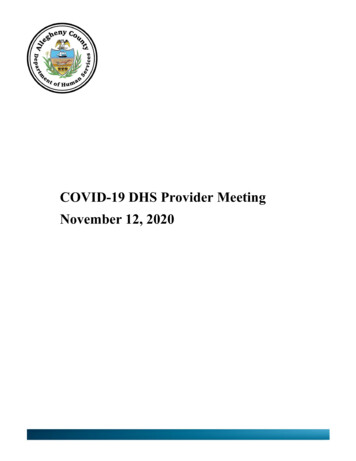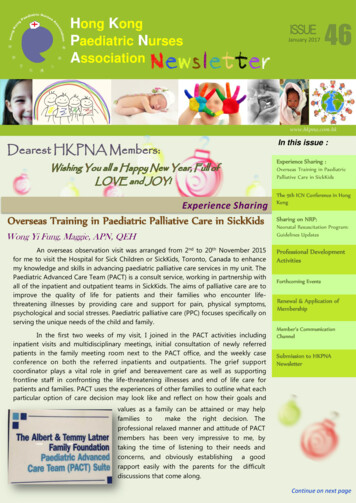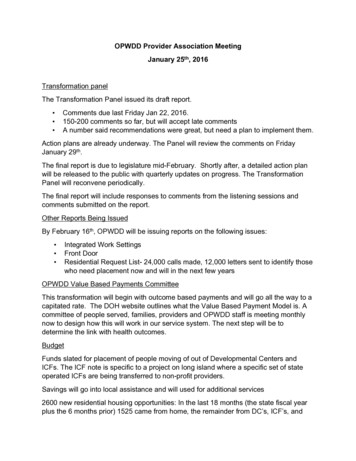
Transcription
OPWDD Provider Association MeetingJanuary 25th, 2016Transformation panelThe Transformation Panel issued its draft report. Comments due last Friday Jan 22, 2016.150-200 comments so far, but will accept late commentsA number said recommendations were great, but need a plan to implement them.Action plans are already underway. The Panel will review the comments on FridayJanuary 29th.The final report is due to legislature mid-February. Shortly after, a detailed action planwill be released to the public with quarterly updates on progress. The TransformationPanel will reconvene periodically.The final report will include responses to comments from the listening sessions andcomments submitted on the report.Other Reports Being IssuedBy February 16th, OPWDD will be issuing reports on the following issues: Integrated Work SettingsFront DoorResidential Request List- 24,000 calls made, 12,000 letters sent to identify thosewho need placement now and will in the next few yearsOPWDD Value Based Payments CommitteeThis transformation will begin with outcome based payments and will go all the way to acapitated rate. The DOH website outlines what the Value Based Payment Model is. Acommittee of people served, families, providers and OPWDD staff is meeting monthlynow to design how this will work in our service system. The next step will be todetermine the link with health outcomes.BudgetFunds slated for placement of people moving of out of Developmental Centers andICFs. The ICF note is specific to a project on long island where a specific set of stateoperated ICFs are being transferred to non-profit providers.Savings will go into local assistance and will used for additional services2600 new residential housing opportunities: In the last 18 months (the state fiscal yearplus the 6 months prior) 1525 came from home, the remainder from DC’s, ICF’s, and
Nursing facilities. The count includes only those new to residential services. In 2014there were 851 placements. A detailed breakdown will be provided at the next ProviderAssociation Meeting. In 2014, there were 851 placements.OPWDD will be issuing a mailing with 2015 numbers and they will also be included inthe OPWDD newsletter.15 million dollar has been allocated for supportive housing- the process to obtain thesefunds has not changed.A PA representative requested details at the next meeting on how all the prior yeardevelopment money was spent. The budget office confirmed that it was all spent andsaid they will provide details to the group.Approved Projects500 Residential which include ISS, Family Care, Supervised, Supportive. These arenew services or the expansion of current services, but these are not backfills.600 Day Services including Group Day Hab500 Employment Supports- SEMP, Pre-Voc, Pathways400 Respite- primarily hourly4000 Other supports including CH, MSC, IBS, Self-DirectionMinimum wageThe Commissioner indicated this was a multiple agency issue (OPWDD, OMH, etc.)and DOB is coordinating this as a state issue. They are conducting an analysis, which isongoing. Providers expressed frustration that an analysis was already done in Augustand DOB agreed it was comprehensive and well done so what is there for them to stillanalyze. NYC is already being impacted and we need action fast.Once the analysis is done, it will be brought to the legislature.At this time, there is no commitment to raise above minimum wage. Providersexpressed concern that no plan has been issued and paying DSP’s minimum wage iswrong. There was discussion about the OPWDD commitment to treat DSP’s asprofessionals and we need them to stand behind this commitment. A concern wasexpress that all levels of the organizations need to be considered because Managersand DSPs cannot make the same wage.Providers indicated Minimum wage is a law so it has to be followed, but services will becut to those with the highest needs if we don’t get OPWDD’s support in raising pay.
SEMPSEMP ADM- in counsel’s office. Providers will be happy because what is billable ismore clear and has been expanded. Innovations training will be billable. The Weeklynote- #9 in the checklist is out.OPWDD indicated they reviewed July-Nov billing data to evaluate the impact of this newbilling method on providers, but they’re not sure it was long enough to give the fullpicture.A provider indicated there are some who need financial help in the interim. TheCommissioner indicated the Contingency fund is gone- it was put into the new rates.A review of agency’s struggling will be done and see how it can be solved.RespiteThe recent survey was completed. Data is being review and should be done soon.Those who are outliers and providing a service may need to consider a different servicemodel.Transportation issue: (OPWDD recently sent correspondence to all providers) Somecounties who authorized state funded transportation to respite should not have. DOHfound out and is telling them to stop. This only appears to be a handful or providers.You would know if it were you. This is state funded transportation only. This doesn’tapply to most. This doesn’t mean transportation can’t be provided during respite.Waiver renewalThe updated Waiver is published on the website. Recent Webex’s were held to discussthe Waiver and audio recordings are on the OPWDD website. Q&A finalized and will beout soon.Providers who requested paper copies, they will be available at regional offices.Comments extended to March 4th.4 new changes:1)2)3)4)High needs funding (for people new to services)Respite feesAuspice change- providers get the higher rateTechnical change related to the Template fundingThis goes back to 10/1/4 – this is a retroactive actionTransportation Vendor Enrollment for Day Habilitation and Residential ProvidersLate in December, providers received communication from DOH regarding enrollmentas a Medicaid transportation vendor. OPWDD and DOH are indefinitely delaying the
effective date until its impact is better understood. Currently they are working on acrosswalk of regulations that already exist due to being a Medicaid provider. Providershave indicated that current regulations are sufficient and vendor enrollment is justanother layer. DOH didn’t realize the extent of the impact of this until they discussed itfurther with OPWDD. They are working on getting out the letter to say there should beno disruption of servicesTwo work group sessions with transportation providers and service providers will beformed to get details on how things really work.At the next Provider Association Meeting, there will be an outline provided on what’shappened.CAS Update (PowerPoint will come with the notes)Goal- to have a standardized automated assessment tool. This is a conflict freeassessment which is meeting CMS requirements. OPWDD wants to ensure those withsimilar needs have similar resources. Two years of verifications has been done andOPWDD will begin rolling out the CAS in March. The IT System will be up and going inFebruary. Tabs and Choices will be updated in March to share the CAS data. Webinarswill be held in Feb and March.Those who have been identified as a priority group is who will receive the CASAssessment first, starting in March including: Newly eligible for services, over the age of 18Children in the system who turn 18Self-directing with budget authority- OPWDD will be doing an analysis ofvariables PRAs. (There is no more money to increase PRA’s in total, butwhen funds are tied to the CAS down the road, some many see anincrease in PRA while others with less needs see a decrease.People living in IRA’sPeople receiving Specialized or Template fundingFIDA- eligible people (not just those enrolled)This tool is for adults not children. The initial assessments will be done by state staff.These staff completed the CAS with 1100 people during the study and are well trained.People get to decide where they want to be assessed such as at their home, a programthey attend, etc. There will be an effort to be efficient in the administering for example ifthe Assessor goes to an IRA to conduct the CAS, the other people who live there willalso get the tool as a way to avoid multiple trips.Within 24 hours after the assessment is completed, the CAS results should be availablein Choices. MSC’s and regional OPWDD staff will have access to ensure the person’sneeds are being met. Written communication such as FAQ will be available soon.
A subcommittee of the Transformation Panel will be formed to look at the data to createan acuity model for payment. Acuity measures will be developed. Right now the tool isbeing used to assess needs. Assigning an economic value to those needs will comelater.Where a person has specialized needs, such as being deaf, OPWDD is ensuring thatthe training provided and training manual include how to handle. This will include thatthe assessor seeking assistance from those who the person successfully communicateswith.SUNY Albany did a review of the CAS data collect so far and data is positive. Theyverbally confirmed the tool is valid. The written report isn’t ready yet, but OPWDD sawno need to delay implementing this long awaited assessment.There are 100,000 people in the system, so getting this done will take time. The roll outwill occur with randomly selected people and settings, starting with the abovementioned priority groups.Providers expressed concern that while we’re waiting, PRA’s will not be increases. Theresponse was there will be opportunities to look at it. Total dollars won’t increase, butfunds may be shifted between people.Rate Transformation UpdateRespite survey- 50 Agency’s still need to respond, but so far they believe: 1 to 1 fees are highGroup is opposite, too low.Once they get the remaining surveys, they will review the rates.7/1 supportive rates posted on 12/197/1 supervised rates posted 1/21Target date for vacancy and retainer days 2/5/16.Some providers billed 14 retainer days and stopped. They should not have done this.Even though there is only payment for the first 14, all need to be submitted. If notsubmitted, DOH counts those days as vacancy days. When OMIG does a review ofproviders, they will see that a provider is getting paid a vacancy day while the person isreceiving a Medicaid paid service outside of the home. This will be an issue of improperbilling. DOH is paying those days in vacancies now and the window to fix it is over.OPWDD has been provided the list of who made this error and will be conducting followup. (A question was asked- what if a provider comes forward and says you’re paying metoo much for vacancy because I made this error. DOH said if a provider self discloses,we’ll have to fix it).
DOH also indicated for those under or close to 5%, it matters. If their vacancy is over5%, it doesn’t matter because that’s the cap.January property update will be in rates by the end of Feb, goes back to 7/1/15.If you had property changes, they will go in the 7/1/15 rates.ICF AR balance recoveryOPWDD has spread AR balances across all providers. The adjustment is 15%. Theinstructions were clear providers should have emailed “I will be sending you a check”,and if you didn’t, you’re still getting the 15% taken.Community Service Fund40 million being given and will be paid on 4/1/16 (it’s possible the payments aredelayed, but contracts will be out by that time). Letter to come shortly to notify if you gotit.Will be issuing a contract 7/1/4- 6/30/16, in July 2016, 7/1/16-6/30/17. These will bereconciled to actual expenditures in total for the 3 year period. These were based on the7/1/14 rates so there will have been some changes since the rates changed.Looking at a Phase 2. There will be an application for those programs that had a ratetransformed as of 7/1/15. This includes: SEMP, Pre-Voc, Respite, Agency sponsoredfamily care. No decision yet on what CFR will be used.Phase 2- 7/1/15-6/30/17 – reconciled over two year period.
more clear and has been expanded. Innovations training will be billable. The Weekly note- #9 in the checklist is out. OPWDD indicated they reviewed July-Nov billing data to evaluate the impact of this new billing method on providers, but they’re not sure it was long enough to give the full picture.
